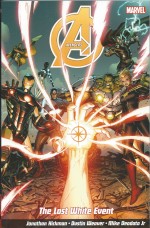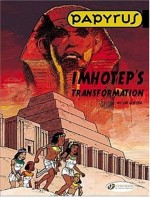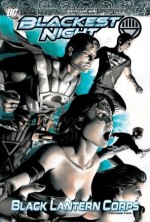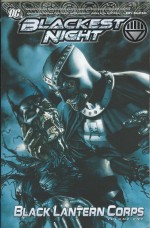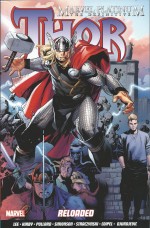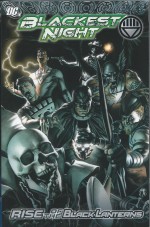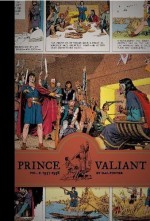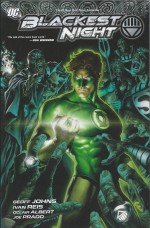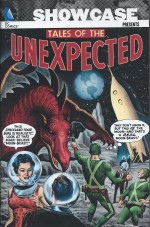
By Jack Miller, Bernard Baily, Bill Ely, Jack Kirby, Mort Meskin, Sheldon Moldoff, Ruben Moriera, George Papp, John Prentice, Leonard Starr & various (DC Comics)
ISBN: 978-1-4012-3520-8
American comicbooks started rather slowly until the invention of superheroes unleashed a torrent of creative imitation and established a new entertainment genre. Implacably vested in World War Two, the Overman swept all before him (occasional her or it) until the troops came home and the more traditional themes and heroes resurfaced and eventually supplanted the Fights ‘n’ Tights crowd.
Whilst a new generation of kids began buying and collecting, many of the first fans also retained their four-colour habit but increasingly sought older themes in the reading matter. The war years had irrevocably altered the psychological landscape of the readership, and as a more world-weary, cynical young public came to see that all the fighting and dying hadn’t really changed anything, their chosen forms of entertainment (film and prose as well as comics) increasingly reflected this.
As well as Western, War and Crime comics, celebrity tie-ins, madcap escapist comedy and anthropomorphic funny animal features were immediately resurgent, but gradually another of those cyclical revivals of spiritualism and a public fascination with the arcane led to a wave of impressive, evocative and shockingly addictive horror comics.
There had been grisly, gory and supernatural stars before, including a pantheon of ghosts, monsters and wizards draped in mystery-man garb and trappings (the Spectre, Mr. Justice, Sgt. Spook, Frankenstein, The Heap, Sargon the Sorcerer, Zatara, Zambini the Miracle Man, Kardak the Mystic, Dr. Fate and dozens of others), but these had been victims of circumstance: the Unknown as a power source for super-heroics. Now the focus shifted to ordinary mortals thrown into a world beyond their ken with the intention of unsettling, not vicariously empowering the reader.
Almost every publisher jumped on the increasingly popular bandwagon, with B & I (which became the magical one-man-band Richard E. Hughes’ American Comics Group) launching the first regularly published horror comic in the Autumn of 1948.
Technically speaking, Adventures Into the Unknown was pipped at the post by Avon who had released an impressive single issue entitled Eerie in January 1947 before reviving the title by launching a regular series in 1951. All the meanwhile, however, parents’ favourite Classics Illustrated had long been milking the literary end of the genre with adaptations of the Headless Horseman, Dr. Jekyll and Mr. Hyde (both 1943), The Hunchback of Notre Dame (1944) and Frankenstein (1945) among others.
As long as we’re keeping score, this was also the period in which Joe Simon & Jack Kirby identified another “mature market†gap and invented the Romance comic (Young Romance #1, September 1947) but they too saw the sales potential for spooky material, resulting in the seminal Black Magic (1950) and boldly obscure psychological drama anthology Strange World of Your Dreams (1952).
The company that would become DC Comics bowed to the inevitable and launched a comparatively straight-laced anthology that nevertheless became one of their longest-running and most influential titles with the December 1951/January 1952 launch of The House of Mystery. Its success led to a raft of such creature-filled fantasy compendiums in the years that followed such as Sensation Mystery, My Greatest Adventure, House of Secrets and, in 1956, Tales of the Unexpected…
A hysterical censorship scandal which led to witch-hunting hearings (check out Senate Subcommittee on Juvenile Delinquency, April- June 1954 on your search engine of choice) was derailed by the industry adopting a castrating straitjacket of draconian self-regulatory rules. Horror titles produced under the aegis and emblem of the Comics Code Authority were sanitised and anodyne affairs in terms of Shock and Gore, even though the market’s appetite for suspense and the uncanny was still high…
Stories were dialled back into marvellously illustrated, rationalistic, fantasy-adventure vehicles which dominated until the 1960s when super-heroes (which had begun to creep back after Julius Schwartz reintroduced the Flash in Showcase #4, 1956) finally overtook them.
This mammoth monochrome compilation offers a stunning voyage to the fantastic outer limits of 1950s imagination, collecting the first 20 issues of the charmingly enthralling anthology – produced under the watchful eyes of the Comics Code Authority – cover dates February/March 1956 to December 1957 and starts with a quartet of intriguing, beautifully rendered pocket thrillers.
Sadly for me and you records are spotty and many of the authors remain unsung (although possible candidates include Dave Wood, Bill Finger, Ed Herron, Joe Samachson, George Kashdan, Jack Miller and Otto Binder and I’ll just guess whenever I’m more than half-certain) but the pictorial pioneers at least can be deservedly celebrated…
Behind a captivating cover by Bill Ely, Tales of the Unexpected #1 begins the uncanny excursions with ‘The Out-of-The-World Club’, drawn by the astoundingly precise John Prentice, which detailed the unearthly secret of a night-spot offering truly original groovy sounds, whilst ‘The Dream Lamp’, limned by Leonard Starr, took a bucolic glance at a device which seemed able to perform impossible feats.
Jack Miller, Howard Purcell & Charles Paris then ironically revealed ‘The Secret of Cell Sixteen’ which fooled yet one more prisoner in the Bastille, after which the debut issue ended with a bleak alien invasion fable in ‘The Cartoon that Came to Life’ by Otto Binder & Bill Ely.
Issue #2 offered the uncredited conundrum of ‘The Magic Hats of M’sieu La Farge’ (art by Ruben Moreira) which saw ordinary folk impelled to perform extraordinary feats when wearing the titfers of famous dead folk, whilst ‘The Fastest Man Alive’ (drawn by Bill Draut & Mort Meskin) disclosed how an obsessive rivalry brought destruction upon a man forever relegated to second best behind his exceptional best friend…
‘The Record of Doom’ (Ely art) apparently drove listeners to suicide until a canny cop uncovered the truth, but ‘The Gorilla who Saved the World’ (Starr) was as incredible and alien as you’d expect in a tale of sharp sci-fi suspense…
Issue #3 opened with Purcell’s ‘The Highway to Tomorrow’ wherein a motorway through Native American sacred lands almost resulted in a new uprising, after which Meskin’s ‘The Man Nobody Could See’ revisited the old plot of an invisible criminal. ‘I Lost My Past’ (illustrated by Mort Drucker) recounted an implausibly complex scheme to cure an amnesiac before ‘The Man with 100 Wigs’, by Miller & Prentice, featured a genuinely compelling mystery about a petty thief who stole a sorcerer’s chest filled with hairpieces imparting uncanny power to the wearer…
The mix of cop stories, aliens and the arcane acts clearly struck a chord as, with Tales of the Unexpected #4, the comic was promoted to monthly.
‘Seven Steps to the Unknown’ (Ely) continued the eclectic winning formula through a perilous puzzle regarding a group of complete strangers inexplicably linked and targeted for murder, whilst ‘The Day I Broke All Records’, illustrated by Sheldon Moldoff, followed a top athlete who gained something “extra†after finding an elixir once favoured by unbeatable Roman gladiator Apulius…
Then a murderer was brought to justice after becoming obsessed with ‘The Flowers of Sorcery’ (Starr) whilst ‘The House Where Dreams Come True’ (Prentice) offered a far kinder tale of human generosity that will melt the heart of the most jaded reader.
In #5 ‘The Man Who Laughed at Locks’ (Moreira) disclosed the inevitable fate of a cheat when rival inventors clashed, ‘I Was Bewitched for a Day’ (Ely) revealed how easily domestic reality can be overturned and Moldoff portrayed the bewilderment of an Art Investigator faced with ‘The Living Paintings’ before Miller & Prentice again triumphed with the tale of an actor literally possessed by his role in ‘The Second Life of Geoffrey Hawkes’…
TotU #6 opened with ‘The Telecast from the Future’ (drawn by George Papp) as a technician foolishly convinced himself that his gear hadn’t really opened a peephole into tomorrow, whilst Ely’s ‘Dial M for Magic’ focussed on a prestidigitator’s club that auditioned an amazing applicant who didn’t just do “tricksâ€â€¦
‘The Forbidden Flowers’ (Moldoff) then exposed a killer who thought himself safe, after which Moreira’s ‘The Girl in the Bottle’ led an unsuspecting oceanographer into fantastic peril and another incredible criminal scam.
Golden Age great Bernard Baily joined the rotating art crew with #7 as ‘The Pen that Never Lied’ visited a number of people, dispensing justice through unvarnished truth, after which ‘Beware, I Can Read your Mind!’ (Moldoff) saw a truth telepath discover the overwhelming cost of his gift.
When a miner found a talking talisman, it promised anything except ‘The Forbidden Wish’ (George Roussos). Tragically it was the only thing the weak-minded man wanted…
This issue ended with the art debut of the astounding Nick Cardy who lovingly detailed the fate of a murderous thug who refused to listen to the sage advice of ‘The Face in the Clock!’
Tales of the Unexpected #8 opened with fantastic fantasy as ‘The Man Who Stole a Genie’ (Meskin) slowly succumbed to greed and mania, whilst ‘The Secret of the Elephant’s Tusk’ (Ely art) followed the trail of death that resulted after a poacher killed a sacred pachyderm. Roussos’ ‘The Four Seeds of Destiny’ chillingly revealed the doom that came to a TV reporter who stole relics from a Pharaoh’s tomb before ‘The Camera that Could Rob’ (Starr) proved that, even for a thief with an unbeatable gimmick, mistreating a cat never ends well…
In issue #9 ‘The Amazing Cube’ (possibly scripted by George Kashdan and definitely limned by Baily) saw an unscrupulous gambler fall foul of his own handmade dice, whilst a killer conman got his comeuppance courtesy of ‘The Carbon Copy Man’ (Papp). ‘The Day Nobody Died’ by Roussos is a classic of moody mystery wherein a doctor pursues a dark stranger and regrets catching him, after which a little lad saves the world from alien invasion and know-it-all adults in ‘The Man Who Ate Fire’ (illustrated by Starr).
The tone of the time was gradually turning and sorcerous supernature was slowly succumbing to the Space Age lure of weird science as TotU #10 proved with ‘The Strangest Show on Earth’ (art by Jim Mooney) wherein a bankrupt showman stumbled over a Martian circus. Sadly the bizarre performers had their own agenda to adhere to…
‘The Phantom Mariner’ (Moldoff) followed an obsessed sea captain to his inescapable fate, after which a scientist faced a deadly dilemma after creating ‘The Duplicate Man’ (Ely) and Meskin revealed how an antique collector’s compulsion endangered his life in ‘I Was Slave to the Wizard’s Lamp’…
A criminal inventor paid the ultimate price for his venality in ‘Who Am I?’ by Baily which opened Tales of the Unexpected #11, whilst ‘I Was a Man from the Future’ (Cardy) saw an American mountaineer stumble through a time-warp into adventure and romance in15th century France and ‘The Ghost of Hollywood’ (Ely) confounded the special effects designer determined to debunk it.
Starr then closed out the issue with ‘The Man Who Hated Green’, as an artist embarked on an extraordinary campaign of terror…
Issue #12 began with Cardy’s tale of a quartet of escaped convicts who terrorised three little old ladies and were cursed by ‘The Four Threads of Doom’, after which ‘The Witch’s Statues’ (Meskin) proved to be more scurrilous scam than sinister sorcery.
Following a downturn in the industry, Jack Kirby briefly returned to National/DC at this time: producing mystery tales and drawing Green Arrow all whilst preparing his newspaper strip Sky Masters of the Space Force.
He also re-packaged for Showcase an original team concept kicking around in his head since he and Joe Simon had closed the innovative but unfortunate Mainline Comics. Blending explosive adventure with the precepts of mystery comics, Challengers of the Unknown became the pattern for the entire Silver Age superhero resurgence…
After years of working for others, Simon & Kirby had established their own publishing company, producing comics for a more sophisticated audience, only to find themselves in a sales downturn and awash in public hysteria generated by the aforementioned anti-comic pogrom of US Senator Estes Kefauver and psychologist Dr. Frederic Wertham.
Simon quit the business for advertising, but Kirby soldiered on, taking his skills and ideas to a number of safer, if less experimental, companies.
Here his run of short fantastic suspense tales commences with ‘The All-Seeing Eye’ wherein a journalist responsible for many impossible scoops realises that the ancient artefact he employs is more dangerous than beneficial…
The issue ends with Ely’s rousing thriller ‘The Indestructible Man’ wherein a stuntman with innate invulnerability decided to get rich quick no matter who gets hurt…
In #13 an amnesiac traced his lost past by seeking out ‘Weapons of Destiny’ (perhaps Binder with Ely art), whilst ‘The Thing from the Skies’ (Meskin) initially proved a boon but ultimately the downfall for a murdering conman. A ghostly ‘Second Warning’ (Papp) saved a tourist when he visited the battlefields of WWII, after which ‘I Was a Prisoner of the Supernatural’ (France E. Herron & Cardy) revealed how an actor escaped a deal with the devil before Herron & Kirby stole the show with a gripping crime-caper in ‘The Face Behind the Mask’…
Tales of the Unexpected #14 started with Meskin’s ‘The Forbidden Game’ as an embezzler played fast and loose with a wagering wizard, followed by ‘Cry, Clown, Cry’ (Baily) which saw a baffled son ignore his father’s injunction not to follow the family tradition to be a gag-man.
Papp pictured the fate of a swindler who wanted folk to believe he was ‘The Man Who Owned King Arthur’s Sword’ and Moldoff finished up proceedings as a crook was haunted by ‘The Green Gorilla’ created by his misdeeds.
Kirby led off in #15, his ‘Three Wishes to Doom’ proving that even with a genie’s lamp crime does not pay, after which ‘The Sinister Cannon’ (Baily) employed by an insidious alien infiltrator proved far more than it appeared. ‘The Rainbow Man’ (Roussos) was a scientific bandit who overestimated the efficacy of his camouflage discovery and ‘The City of Three Dooms’ by Meskin wrapped up things with a mesmerising time-travel romp starring Nazi submariners on a voyage to infinity…
There’s an inexplicable frisson in ‘The Magic Hammer’ by Kirby which opens #16 as the King of Comics relates how a prospector finds a mallet capable of creating storms and goes into the rainmaking business… until the original owner turns up…
That superb vignette is augmented by ‘I Was a Spy for Them’ (Meskin) as a canny physicist turned the tables on the star men who captured him, a crooked archaeologist gained unbeatable power from an ancient ring and became ‘The Exile from Earth’ (Dave Wood & Moldoff), and Moreira illustrated ‘The Interplanetary Line-Up’, wherein an actual Man from Mars gatecrashed a science fiction writer’s fancy dress party…
In #17 ‘Who is Mr. Ashtar?’ (Kirby) chillingly followed a hotel detective who knew there was something off about the new guest in Room 605, whilst ‘Beware the Thinking Cap’ (Ely) described the rise and fall of a crook who found the device which inspired all the geniuses of history. Baily illustrates how a lifer in jail used a unique method of escape in ‘The Bullet Man’, and the issue ends on ‘The Impossible Voyage’ (Mooney) as a couple of alien pranksters took earth suckers for a ride on what only looked like a fairground attraction…
Mooney takes the lead spot in #18 as ‘The Man Without a World’ rejected Earth only to learn that a life in space is no life at all, whilst ‘The Riddle of the Glass Bubble’ (Meskin) threatened to end all life until a little kid offered an unlikely solution. Cardy opened ‘The Amazing Swap Shop’, where humans could trade “junk†for impossibly useful gadgets before Kirby showed how a clever human saved us all by outwitting ‘The Man Who Collected Planets’.
By now thoroughly gripped in UFO fever, Tales of the Unexpected #19 began with ‘The Man from Two Worlds’ (Cardy) wherein evil Neptunians attempted to abduct an Earth scientist by guile, whereas ‘D-Day on Planet Vulcan’ (Mooney) saw embattled ETs beg our help to end a world-crushing crisis, after which a meteor turned a hapless technician into ‘The Human Lie Detector’ (Ely) and a dotty old eccentric surprised everybody by ending ‘The Menace of the Fireball’ (with art by Bob Brown).
This first terrific tome concludes with issue #20 where ‘The Earth Gladiator’ (Cardy) struggled to save his life and prove Earth worthy of continued existence, an engineer scuppered ‘The Remarkable Mr. Multiplier’ (Ely) before his invention wrecked civilisation and ‘I Was Marooned on Planet Earth’, by Baily, illustrated that every alien incursion was malign or dangerous.
Moreira then brings the cosmic catalogue to a close with ‘You Stole Our Planet’ wherein gigantic space creatures arrived with a strong claim of prior ownership…
Although certainly dated and definitely formulaic, these complex yet uncomplicated suspenseful adventures are drenched in charm, gilded in ingenuity and still sparkle with innocent wit and wonder. Perhaps not to everyone’s taste nowadays, these fantastic exploits are nevertheless an all-ages buffet of fun, thrills and action no fan should miss.
© 1956, 1957, 1958, 2012 DC Comics. All Rights Reserved.
